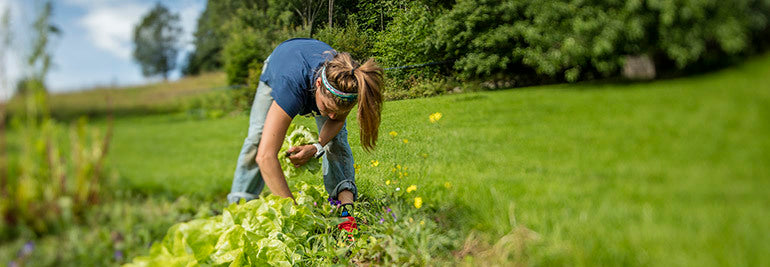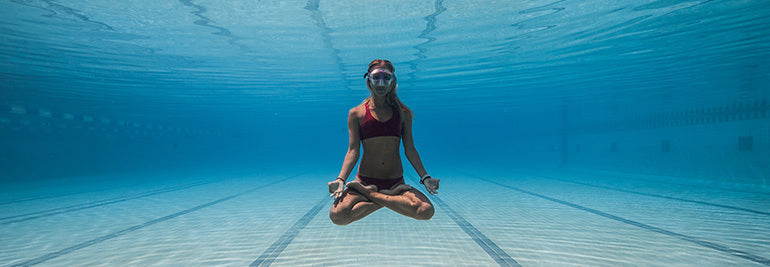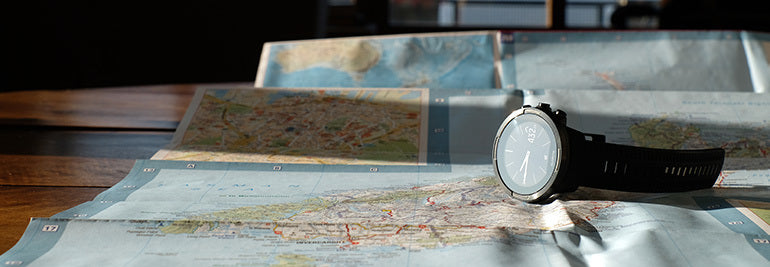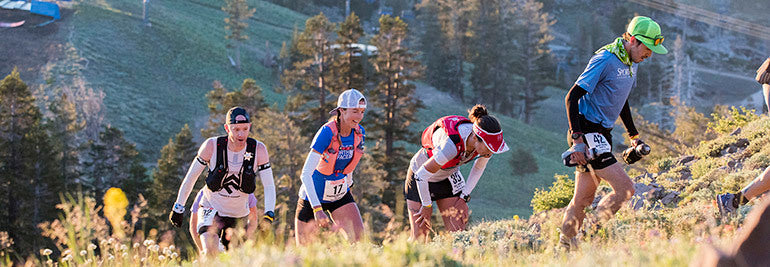

Suunto Blog

Fuelling the engine: talking nutrition with Emelie Forsberg
For an increasing number of people today nutrition isn’t only a question of what food we eat, it’s also about where that food has come from and how it’s been produced.
When she's not in the mountains, you can find Emelie in her garden or preparing delicious meals. © Matti Bernitz
Eating seasonally
For Swedish mountain running champion Emelie Forsberg sustainability plays an important role in her decision making around diet. For this reason Forsberg eats seasonally. “In the winter, for example, I try not to buy fruit or anything transported from far away places,” she says. “For me, the seasons are something to go through.”
Fall, she says, is a time to begin spending more time indoors, thinking, reading and reflecting, slowing down after the summer. Winter, Forsberg says, is a time for taking care of oneself, resting, and recharging. Spring is a time of awakening, coming out of hibernation, and using more energy. Summer is a time of fun and intensity.
Forsberg eats different foods during each season. “I really enjoy eating in the winter,” she says. “For breakfast, I eat porridge with berries on top. I’m living in Scandinavia, and we have many berries and greens, and a lot of herbs. In the winter we eat a lot of potatoes. The best is eating potatoes with olive oil and salt! In summer, we have smoothies, more salads, and colder foods.”
Straight from the earth
Forsberg is also an avid gardener. Her dream is to become as self sufficient as possible. Leafy greens, beans, potatoes, berries, carrots, you name it, Forsberg is growing it. Gardening, working with the earth, being in harmony with the seasons, is a form of spirituality for Forsberg. She believes the fresher it is the better.
© Kilian Jornet
Relaxed eating
Listening to her body is a big part of how she eats, rather than following meal plans. “I never have a meal plan,” she says. “In the beginning you need to get into a routine, but now I don’t even think about it anymore. You just need to use your imagination. Some people get obsessed about eating healthy. I’m not like that. I’m relaxed in the way I’m eating.”
Bean power
She is a big fan of beans, and admits to eating them at least once a day. “Even bean cakes and bean cookies,” she laughs. “Like, everything beans – 10 different types of beans, five different types of lentils! When you are vegetarian it’s important to know where you are getting your protein from.”
Easy, go-to meals
Forsberg stores a lot of food in her freezer, including bean burger patties. If it’s going to be a busy week she’ll make a big meal on Monday and store it to have again later in the week. “I like to have back up meals.
“I also make pesto out of everything, any type of green, even the tops of carrots,” she says. “A bit of garlic, olive oil, sun seed flower, nuts and seeds, and I eat it with pasta. I was eating it with bean pasta just now!
Salad with carrot and lentil patties
Salad (green salad, rocket, carrots, beets, brussels and onion from the garden)
Patties: 3 carrots, grated4 dl of red lentils; slightly cooked, can be a bit hard.1/2 an onion2 tbsp spoon of tahinia little parsleychili, salt and black pepperMix it all together and fry, or bake them in the oven!
Lead image: Photo by Blair Fraser on Unsplash.

Why yoga is the perfect complement to freediving ... and vice versa
Kate Middleton teaches freediving and offers yoga teacher training courses. © Heather Bonker
Living on Gili Trawangan, a small island close to Bali, Kate Middleton spends her days freediving, doing yoga, writing poetry and training yoga teachers.
It’s a dreamy life in paradise. But training for freediving demands focus and discipline. Middleton regularly competes in elite freediving competitions, such as Vertical Blue, and takes home wins and new records. Her yoga practice helps her stay relaxed, supple and strong.
“Perhaps the biggest draw to freediving is the peace that comes from total immersion in nature,” Middleton says. “You might call it oneness, presence, connection, or, the ‘state of yoga’. At the heart of both yoga and freediving lies this gift of simultaneously being in contact with the inner and outer world.”
© Mike Board
It’s not just about fancy poses
Yoga involves much more than the physical postures, called asanas, most commonly associated with it. Aside from asana, there’s also pranayama and dhyana, breathing exercises, and meditation. Each play a key role, Middleton says.
The asana, or physical practice, results in greater physical strength, flexibility, mobility and body awareness. Pranayama, which is traditionally believed to enhance the life force or prana, increases body awareness, lung flexibility and C02 tolerance. Meditation fosters greater self-awareness, compassion, curiosity, focus, and self-kindness.
“The greatest way yoga supports my freediving journey is how it prioritises relationship to self,” Middleton says. “When self-love is there, anything is possible. Without it, nothing is enjoyable.
“If I let my inner critic run my dive session then no depth will feel like enough. When I dive from the heart, for the pleasure of being in my body and in the water, depth is irrelevant and it’s a spiritual experience.”
Press play to do a simple yoga class with Kate Middleton
Here are three reasons why yoga is a perfect compliment to freediving:
Your personal laboratory
“You can think of freediving as field research and your yoga mat as the laboratory,” Middleton says. “It’s here, back on land, where you can empty all of your findings and start to sort through them, or let them sort themselves out, one breath at a time.”
Better breath holds
“If you prefer a simple and clear outlook on the yoga for freediving movement, consider the fact we cannot be at peace and stressed out at the same time. Yoga reduces stress, which lowers metabolic rate and oxygen consumption. More yoga, therefore, results in a longer breath hold. You will also have more comfortable breath holds and longer dives. Oh yeah, and it’s also hard to have fun while feeling tense, so more yoga equals more fun!”
Know your body better
“Yoga also teaches greater body awareness. We can break that down into interoception and exteroception; the awareness of your inner body and your body in space. This helps you tune in to how you’re feeling on a dive so that you can relax into the process and also know when you need to safely surface.
“As far as physiological adaptation, yoga asana is an immensely effective way to increase your lung flexibility as well as your mobility and strength.”
How to get started
Middleton recommends finding an authentic teacher who you connect with and feel inspired by. Sometimes that might take a while. Until then, here are four tips to get started:
Learn online
If you’re totally new to yoga, try doing yoga with Middleton in the video above. And check out a few free online classes on Youtube or a platform like yogaglo.com. That way you can try a few styles and see what you like.
Start slowly
Many of us have a tendency to push too fast, too soon. With yoga this can sometimes lead to injury. Take your time; start gently, learn to relax and breathe well first before trying more demanding asanas or sequences.
Get one-on-one
Sometimes the fastest way to learn is to have one-on-one classes. That way you have the teacher’s full attention, and can work specifically around your goals and to support your freediving.
Immerse yourself
If you are looking for an immersive experience, go and learn yoga and freediving with Middleton! She hosts yoga and freediving retreats and training camps on Gili and Bali.
Lead images: © Mike Board
More articles about yoga and freediving:
Say namaste to the freediving island yogi
Finding harmony in the deep blue sea
The one thing every freediver needs

Running every single street in San Francisco – and why the math counts
© Max Romey/ Wandering Fever
When Rickey Gates visited his home town in Colorado recently he bumped into a high school friend who ran in the same cross country team. Now assistant professor of aerospace engineering at University of Maryland College Park, Mike Otte’s eyes lit up when Gates told him about his new running project – to run every single street in San Francisco in six weeks.
“I should have known by his reaction right there that this is not a simple problem,” Gates says. “It’s a complicated problem. I’m learning that now.”
Photo by Robert Bye on Unsplash
Like all big cities, San Francisco has a dense grid pattern of streets. The planning challenge is working out how to run them all, while minimising repetition. Get that wrong and the distance quickly increases. Otte has helped calculate and plot the complex route.
The total distance is about 2000 km, not including all the doubling back and forth required for Gates to accomplish running every single street once. Adding to the challenge are San Francisco’s famous hills and crazy streets. So far he’s covered about 650 km and nearly 20000 m of climbing.
“I haven’t even hit the biggest hills and the steepest streets yet,” Gates says. “It’s a big project. I greatly underestimated the challenge of efficient route finding. Hours are spent trying to figure out which way to go. Fun none the less though.”
© Max Romey/ Wandering Fever
Gates got the idea when he came to the end of his epic run across the United States last year. He started in South Carolina and finished in San Francisco, where he has lived off and on for four years. When he ran into the city he realised its immensity.
“It occured to me that knowing a huge country, and to cross it, is one thing, and knowing a city by really immersing yourself in it is a completely different thing,” he says. “That’s when I came up with this idea to run every street in this city I’ve called home.”
To prepare for the project he gained extra weight, which he lost in the first week of running. Into the second week now, pounding the pavement every day is taking a toll on his body. But the hardest thing for Gates is staying patient.
“I have to remind myself it just takes time ticking off the miles,” he says. “The biggest difference between the run across the country and this run is when I started my run across the country I couldn’t see the other side. Every single day here I’m looking at the immensity of this project and it’s important to keep in mind that I hope to do this in about six weeks, and to not get overwhelmed by the size of it.”
© Max Romey/ Wandering Fever
Gates isn’t the first person to run every street in San Francisco. Runners have done the same thing in other cities, too. However, Gates hopes his effort inspires others to get out to explore their cities. His high school running coach has got on board, and is now running all the streets back in his hometown, a total distance of about 320 km.
To encourage people to get out and explore their locality, Gates is going to give away one of his Suunto 9 watches. To have a chance, run every street in your neighborhood, town, city by December 15, and tag Suunto, Salomon and #everysinglestreet on Instagram, and he’ll choose a winner.
“It really opens your eyes to the place you live. I think that’s the most magical part about it.”
Lead image: Photo by Robert Bye on Unsplash

Too epic for paper maps: thru-hiking New Zealand with a Suunto 9
Cartophile (map lover) and long distance hiker and biker Jean Hacquart grew up in the French Alps using paper maps, and ordinarily prefers having one in his hands when he’s navigating in wild and remote country.
“I grew up with paper maps, my father teaching me how to read and to use them when we were hiking together,” he says. “There is something I love about the feeling of having them in my hands.”
But some adventures are too long, too big, to carry a bevy of maps. That’s why for his latest epic adventure travelling the length of New Zealand one way by foot, then back again by bike, he’s using a Suunto 9 to do the job. Hacquart’s adventure begins in November 2018 and ends in April 2019. Follow his adventure on Instagram.
It’s important to remember Hacquart’s decision isn’t a good idea for everyone. New Zealand’s vast mountain ranges and forests are places to treat with caution and respect. Rapid weather changes, and remoteness can catch people out. River crossings are the most dangerous factor in the outdoors, along with the risk of falling.
New Zealand’s Department of Conservation recommends having maps and a compass when entering its national parks, and knowing how to use them. Good quality topographical maps are available online for free here.
Having grown up in the Alps, Hacquart has experience with wild places. In 2016, he hiked the rugged 4300 km Pacific Crest Trail in the US. Paper maps were his navigation tool of choice.
“I didn’t think twice and carried paper maps all the way,” he says. “With them and my old Suunto watch with a compass and a barometer, I was confident and efficient. But I was really heavy too.”
To reduce his weight for his New Zealand trip, Hacquart tried to find a three-in-one device, and found it in a Suunto 9. Specifically designed for long distance adventures, the 9 is Suunto’s latest top line adventure watch.
“It’s a GPS to follow the route I planned at home on my computer,” he says. “It’s a barometer to know the altitude and when the weather is changing, and it’s a compass to be sure to follow the right direction, even if I don’t have GPS reception.
“I also needed a tool that was light, easy to use, weatherproof, with an amazingly long battery life. Not that easy to find!”
Hacquart has been testing his Suunto 9 over the last few weeks before his departure to New Zealand. He says it exceeded all his requirements.
“It’s a super reliable device and I never run out of battery during my multi-day hikes,” he says. “So goodbye paper maps, I am fully confident to begin my new project with it on my wrist. Let the adventure begin!”

Want to race Western States 2019? Here’s your chance to win an entry!
The Western States 100-Mile Endurance Race is the world’s oldest 100-mile trail trace race, bringing hundreds of athletes together each year to navigate the challenging route across the Sierra Nevada Mountains, from Squaw Valley to Auburn, California. With over 18,000 feet of climbing and nearly 23,000 feet of descent, the race has become one of one of the ultimate tests of endurance in the world.
“Western States is one of the most highly regarded ultramarathons in the world and we are honored by the opportunity to connect with a wonderful race community,” says Suunto Americas Marketing Manager Caleb Whittle.
“Given Suunto’s heritage in navigation as well as the ongoing success of our Suunto 9 sports watch, this partnership is an ideal fit,” says Caleb.
In the Suunto 9, Western States athletes have one of the ultimate timepieces available to ultra-distance runners. Highlights of the Suunto 9 include customized battery settings and 120-hour battery life, as well as the unique FusedTrack technology, which improves GPS accuracy while extending battery life.
What does the ultra-running community mean to you?
As the exclusive sports watch sponsor for the California event, we will grant one lucky winner a coveted place at the 2019 start line and a Suunto 9 watch through the fan-generated #SuuntoUltraCommunity contest, which runs through November 8 – 27, 2018.
To participate in the contest, Western States hopefuls should post a photo on Instagram, Facebook or Twitter with a caption describing what the community of ultra-running means to them, along with the hashtag #SuuntoUltraCommunity. In order to qualify, all entrants must meet all requirements to run the Western States 100, including having finished a qualifying race and applied for the lottery by November 10, 2018. The winner will be announced at the lottery drawing on December 1, 2018.
All images by: Luis Escobar
Social Media Terms and Conditions
There is no purchase necessary to enter this contest; however, participant must be willing to pay the race entry fee ($450USD) upon announcement (see wser.org for more information)
By entering this competition, an entrant is indicating his/her agreement to be bound by these terms and conditions.
The contest will be run on Instagram, Facebook, and Twitter
Only one entry will be accepted per person.
The contest is open to citizens of the Fifty United States and the District of Columbia, Denmark, Germany, Spain, France, Norway, Finland, Sweden, United Kingdom, Russia, Canada (excluding the province of Quebec) Japan, Australia, Austria and New Zealand.
Closing date for entry will be November 27, 2018. After this date the no further entries to the competition will be permitted.
No responsibility can be accepted for entries not received for whatever reason.
The rules of the competition and how to enter are as follows:
Post an image on Instagram, Facebook, or Twitter of your interpretation of the community of ultra-running
In the caption/description, explain what the community of ultra-running means to you
Tag @Suunto and use the hashtag #SuuntoUltraCommunity
Suunto reserves the right to cancel or amend the competition and these terms and conditions without notice in the event of a catastrophe, war, civil or military disturbance, act of God or any actual or anticipated breach of any applicable law or regulation or any other event outside of the promoter’s control. Any changes to the competition will be notified to entrants as soon as possible by the promoter.
Suunto is not responsible for inaccurate prize details supplied to any entrant by any third party connected with this competition.
The prize is as follows: One (1) entry into the 2019 Western States 100-Mile Endurance Run and one (1) Suunto 9 Watch.
The prize is as stated and no cash or other alternatives will be offered. The prizes are not transferable. Prizes are subject to availability and we reserve the right to substitute any prize with another of equivalent value without giving notice.
The winner will be chosen by a panel of Suunto employees
The winner will be announced live during the Lottery drawing on December 1, 2018 and on the WSER website no later than 2pm PST on the same day.
Suunto’s decision in respect of all matters to do with the competition will be final and no correspondence will be entered into.
By entering this competition, an entrant is indicating his/her agreement to be bound by these terms and conditions.
The competition and these terms and conditions will be governed by United States of America law and any disputes will be subject to the exclusive jurisdiction of the courts of the United States of America
The winner agrees to the use of his/her name and image in any publicity material, as well as their entry. Any personal data relating to the winner or any other entrants will be used solely in accordance with current US data protection legislation and will not be disclosed to a third party without the entrant’s prior consent.
Entry into the competition will be deemed as acceptance of these terms and conditions.
This promotion is in no way sponsored, endorsed or administered by, or associated with, Facebook, Twitter or any other Social Network. You are providing your information to Suunto and not to any other party.
Suunto shall have the right, at its sole discretion and at any time, to change or modify these terms and conditions, such change shall be effective immediately upon posting to this webpage.

Fuelling the engine: a commonsense approach to nutrition
Eating well is essential for athletes. The bigger your goal, the more nutrition has to play a central part of your training plan. Take shortcuts on how you eat, and you’ll eventually pay for it.
But the topic of diet, what we should and shouldn’t eat, has become touchy and confusing. There are all sorts of diets out there – paleolithic, vegan, gluten-free, low carb, high carb – each one with advocates claiming their way is the one true way.
Matias Anthoni prefers a common sense approach to nutrition.
“Nowadays it’s become a big topic, and everyone has his or her own opinion, and it seems hard to find the real truth,” says Matias Anthoni, Suunto’s in-house personal trainer. “It’s become trendy to follow a kind of diet.”
Anthoni, 26, has a Bachelor in Sports and Health Promotion, and gives nutritional advice to Suunto employees, as well as personal fitness training. He takes a simple, “nonsectarian” approach to nutrition, rather than buying into the hype of one diet over another.
“As long as you get the nutrients it doesn’t really matter what diet you follow,” he says. “You can teach your body to thrive on different diets. The body is quite adaptable. But we do need certain basics. The question I always ask is, would my grandma recognize it as food?”
Here are Anthoni’s five down-to-earth tips for good nutrition:
1. Start with your meal rhythm
This is the first topic Anthoni’s raises with his clients during a consultation. Just improving how often you eat can improve what you eat. Many of his clients skip meals or have long breaks between meals; this results in blood sugar levels dropping, then tiredness, and then cravings and impulses for unhealthy snacks.“With a more steady meal rhythm you avoid big spikes in the blood levels, make better decisions, and are less likely to just reach for a chocolate bar,” he says.
Meals should be about three hours apart, and consist of a good breakfast, lunch and dinner, with smaller, healthy snacks in between. “It leads to healthier choices and you’ll have more energy,” Anthoni says.
2. Plan ahead
“You can’t be a top athlete if you are eating poorly; it’s not just about training, it’s about eating as well,” Anthoni says. “It really helps if you plan your meals like you plan your training. Know what you are going to buy and know what you are going to make. When you come home from work, or after a training session, it’s all ready to go.”
3. Follow the Nordic plate model
Anthoni says in Finland there’s a traditional “plate model” or a way to divide your plate into three sections: one half should be salad and vegetables, one quarter should be carbohydrates, and one quarter protein. This balanced plate ensures you will get enough of all the key nutrients.
4. Eat quality food
Quality can seem like a vague notion, so Anthoni recommends a common sense approach here, too. “Have a look at your plate – are there all the colours – red, green, yellow?” he asks. “Are you eating the same thing every day?” Anthoni suggests finding and following basic nutrition guidelines. “They provide a good start, and then make small changes to fit yourself from there,” he says.
5. There’s no one size fits all diet
Deciding what to eat depends on your goals. “The more you move the more you need,” Anthoni says. “If your goal is building muscle mass, then you need more protein. If you are an endurance athlete, eating enough carbohydrates becomes more important. There is no one size fits all, no one plan can fit everyone. You need to have your own plan.”
Lead image: Photo by Roosa Kulju on Unsplash.
READ MORE
Fuelling the engine: talking nutrition with ultra runner Lucy Bartholomew
Fuelling the engine: talking nutrition with triathlete Mel Hauschildt










































































